agAIn
(yet another in a never-ending series of kvetchings by yrs trly on the topic of AI vs. human creativity)
I was looking at some AI images recently when it finally dawned on my why they were simultaneously so bland yet fascinating.
Rorschach tests are random inkblots intended to gain insight into a patient’s worldview by asking them to assign meaning to forms an d colors that literally have no meaning.
In and of themselves, the tests are useless without some foreknowledge of the test subjects mental state and personality.
It means one thing if a ten year old kid who loves monster movies sees Dracula in one set of blots, it means something entirely different if a middle-age woman with no interest in horror films sees the same thing.
We’ve all seen lots of deliberately imitative human art, sometimes created as an homage, sometimes as a parody, sometimes for purely utilitarian purposes such as an artist filling in for another on a comic strip.
But in all of these cases, there is a deliberate attempt by the artist to convey some sort of information.
There is a message being projected out to the world at large.
As such, it conveys a meaning, an intent.
It may not deliver it well…
…but it delivers it.
The image -- even a highly derivative imitative one -- is composed by the human artist based on values and insights they wish to convey to their audience.
On the other hand, AI assigns no values to the images it assembles. Oh, the prompter may have laid out explicit instructions in their prompt, but the same prompt will produce an endless stream of somewhat similar yet far from identical images.
The AI can only function with the values assigned it.
It can not “look” at something a perceive a heretofore unseen value.
Which is why humans viewing AI images are not skillfully guided to a message an artist intends for them to receive but rather are invited to cast their own interpretations on what is pretty much a random collection of images thrown together.
Mind you, this can be a fun exercise. I’ve seen countless AI images that spark story ideas in me widdle head.
Conversely, when I see human generated art -- be it old masters or old comics or just plain old advertising -- I’m not mentally creating a new story but rather looking at one that’s already been told.
And, yeah, I’m fully aware the fictoids I post daily seem to contradict this but they don’t!
Those fictoids are created by taking the intended message and deliberately subverting it.
Trust me, a much harder task to accomplish with AI images.
It strikes me AI art is akin to the dream state.
He run a parade of hallucinations through our minds in our sleep, and out of our human desire for some sort of order, we create order out of the chaos, no matter how surrealistic it may be in the cold light of morning.
I wonder if AI is denying humans the ability to dream, not in the literally biological sense, but in the deeper, more profound spiritual one.
“All men dream: but not equally. Those who dream by night in the dusty recesses of their minds wake up in the day to find it was vanity, but the dreamers of the day are dangerous men, for they may act their dreams with open eyes, to make it possible.” -- T. E. Lawrence
© Buzz Dixon


![A WORLD CALLED GOLGOTHA [poem]](https://images.squarespace-cdn.com/content/v1/590697e7d1758ec4d7669624/1720132226303-RG6MHVTIPYNB886777B5/Golgotha+was+fembots+2023-06-25t15-45-25+SQR.jpg)
![Eremocene [FICTOID]](https://images.squarespace-cdn.com/content/v1/590697e7d1758ec4d7669624/1719619908260-WZ79VJHSHGY3XFF7JLNU/FT+227+Eremocene+-+Jack+Gaughan+SQR.jpg)